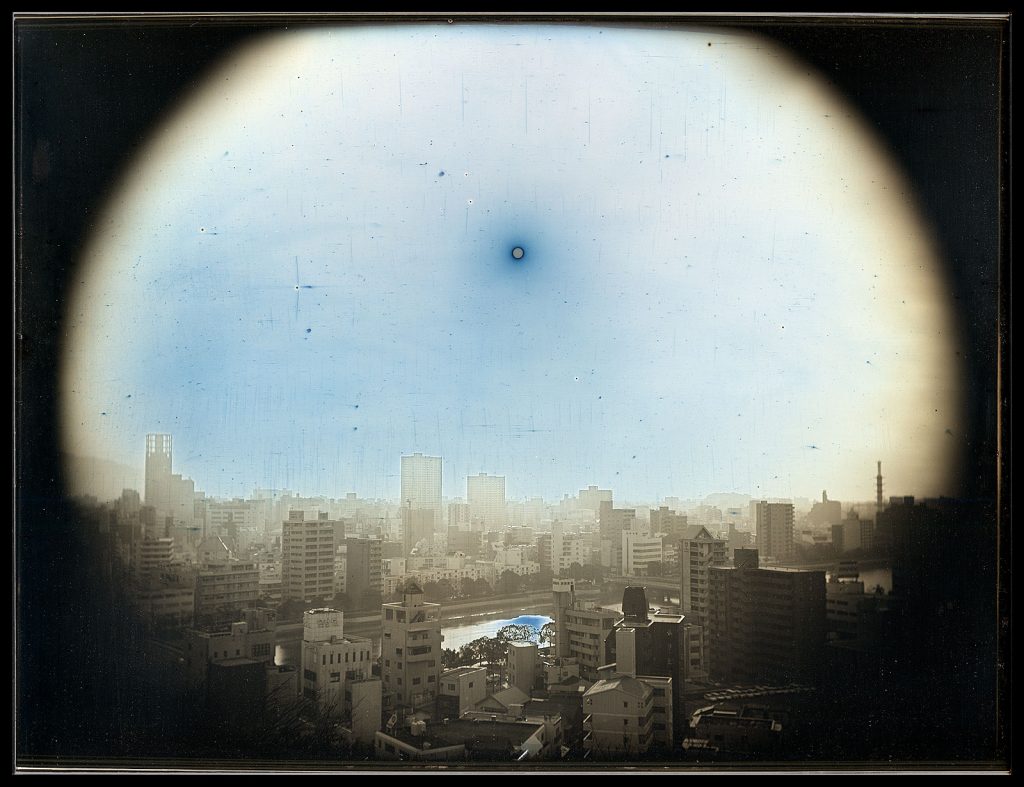長崎/広島(五)四十九の爆心地(グラウンド・ゼロ)
新井卓
(『小さな雑誌』80号(2015年2月号)より転載)
川崎の自宅から長崎へは、東名を抜けて大阪南港まで辿り着き、そこから一晩かけてフェリーで新門司港へ、さらに高速を数時間という道のりである。帰路はいつも、鳴門海峡を渡って山陽道で岡山方面へ。瀬戸内を見て回りたいという気持ちもあったし、なによりその途中に、広島がある。二〇一四年三月、長崎で二週間の撮影を終えてから、ふたたび広島に向かった。
広島/長崎という二つの爆心地(グラウンド・ゼロ)は、記憶の地図の上に、それぞれ孤立した点としてプロットされている。だから、車で移動してみると、いつもその近さに驚かされる。
なぜ、広島と長崎だったのだろうか?
通常それは、当日の気象条件や爆撃機B29の航続距離などから説明されるのだが、それでも、うまくのみ込めない感覚が残る。それはたぶん、二つの都市があまりにも近く、そして東京からあまりにも遠いからだろう。原爆投下候補地としておぼろげに覚えていたのは、小倉、福岡、京都など。東日本は、東京は、目標から外されていたのだろうか?
その答えは、広島平和記念資料館のパネルにあった。
長崎に投下された「ファットマン」は、爆弾中心のプルトニウムを周囲から瞬時に圧縮して臨界を引き起こす、爆縮方式(インプロージョン・タイプ)の原爆である。この大型爆弾を高々度から精確に投下するためには、空中特性の改良や投下訓練が必要とされた。そのために製造された模擬爆弾が、通称「パンプキン爆弾」である。パンプキン爆弾は形状も重量もファットマンとまったく同じように作られていて、高性能炸薬が装填されていた。
パンプキン爆弾はマンハッタン計画の一部であり、第五〇九混成部隊の極秘任務だったので、戦後、日本の市民グループがその事実を突き止めるまで、知られざる存在だった。日本に投下されたパンプキン爆弾は四十九発。東京、名古屋、川崎、いわきをはじめとする日本全土の重要都市が投下候補地点だった。それらのすべての地点が、いわば「未遂の爆心地」である。
広島平和資料館には市街地のジオラマがあり、その中央に、赤いつややかな球体が浮かんでいた。それは、原爆の火球をあらわしていた。人の手によって造り出された、高度五百七十メートルの太陽──それを間近で直視したものはだれもいない。目撃者たちはみな、光を見たと思う間もなく燃え尽きてしまったのだから。(したがって、他者の苦痛を語りうるかどうかを「当事者性」という都合のよい言葉ではかることはできない──なぜなら本当の当事者とは死者たちであり、残されたものたちはみな、少なからず出来事の周縁を生きているのだから。)
翌朝、高校の数学を苦労して思い出しながら、市内各所からみた火球の方位と視角度を計算した。計算が正しければ、たとえば午後四時八分に比治山公園から西北西の空を見あげると、沈みゆく太陽と原爆の火球の位置がぴったり重なるはずだった。
正午から銀板写真(ダゲレオタイプ)を撮影する準備にとりかかり、それから比治山に登った。まだ随分時間があったので、カメラを三脚に据えてゆっくり待つことにした。見晴台のベンチでは、年老いた母親と娘が編み物をしている。年配の女性が自転車を押して、公園の猫たちにえさをやりに来た。
彼岸の太陽は、刻々と、苛烈な早さで地平線に落ちつつあった。三月二十三日午後四時八分。やがてその時は来たが、なにもおこらなかった。一秒間の露光。目の前の光景は変わらず、木々は燃え上がらず、母娘はのんびりと編み物をつづけていた。爆風に叩きつけられることもなく、鳥たちは群れて家路につこうとしていた。──いまはまだ、とりあえず、いまのところは……。
49 Ground Zeros
After shooting for two weeks in Nagasaki, I drove towards Okayama on the Sanyo-do highway, crossing the Naruto Strait. I was curious to look around the Setouchi area, and, more than anything, Hiroshima was on the way.
The two ground zeros, Hiroshima and Nagasaki, are plotted isolated on my memory map, so I’m always surprised to find out how closely they are located to each other, every time I drive.
Why was the atomic bomb detonated over Hiroshima and Nagasaki? Normally it is explained from the weather of the very day or the cruising range of the bomber, B29, but something doesn’t feel right. This is probably because the two cities are located so close together, and so far away from Tokyo. I vaguely remember the proposed site of the bombing: Kokura, Fukuoka, Kyoto, and so on. Was eastern Japan or Tokyo not a target?
The answer to this question was soon found on the panel at the Hiroshima Peace Memorial Museum.
“Fat Man,” detonated over the city of Nagasaki, was an implosion-type nuclear weapon, instantly compressing the plutonium core and causing the explosion. In order to drop this large-scale bomb accurately, improvement in ballistic characteristics and training were required, and “Pumpkin Bombs” were developed as replicas. Its shape and weight were similar to Fat Man, loaded with high power explosives.
The Pumpkin Bomb was developed as a part of the Manhattan Project as a top secret mission of the 509th Composite Group, and it was unknown until a citizen group in Japan tracked down the truth. At least 49 Pumpkin Bombs were detonated in Japan. Major cities all over Japan: Tokyo, Nagoya, Iwaki and others were the proposed site of the detonation. In a way, all of these sites are “attempted ground zeros.”
Over the center of a diorama of the metropolitan area at the Hiroshima Peace Memorial Museum, a shiny red sphere floats in the air. This represents the fireball of the atomic bomb. A man-made sun 570 meters above ground…No man has ever had a straight look at it. Every single witness was burnt out without even noticing the light.
The next morning, I calculated the direction and the visual angle of the fireball seen from various places within the city, having a hard time recalling what I learned in high school algebra. For example, if my calculations are correct, the setting sun and the fireball should overlap if you look up at the west-northwest sky from Hijiyama Park at 4:08pm.
I started preparing the daguerreotype for shooting at noon and climbed up Mt. Hijiyama. I still had plenty of time, so I decided to wait with my camera placed on a tripod. An old mother and her daughter were busy knitting, sitting on the bench at the lookout. An elderly woman came pushing her bike to feed the cats in the park.
It was the Buddhist equinoctial week, and the sun was setting fast towards the horizon. It was 4:08pm, March 23. Then the moment came, but nothing really happened; a one-second exposure. The sight before me was still the same; the trees weren’t burning in flames, and the mother and daughter were till busy knitting. A flock of birds were on their way home, without being struck by a bomb blast. Not now, not for the moment…

2014年3月23日、比治山公園より西北西に見かけの高度570mの太陽、広島、No.1
銀板写真(ダゲレオタイプ)、19x25cm
March 23, 2014, The sun at the apparent altitude of 570m in WNW, Hijiyama Park, Hiroshima
2014
Comments are closed, but trackbacks and pingbacks are open.